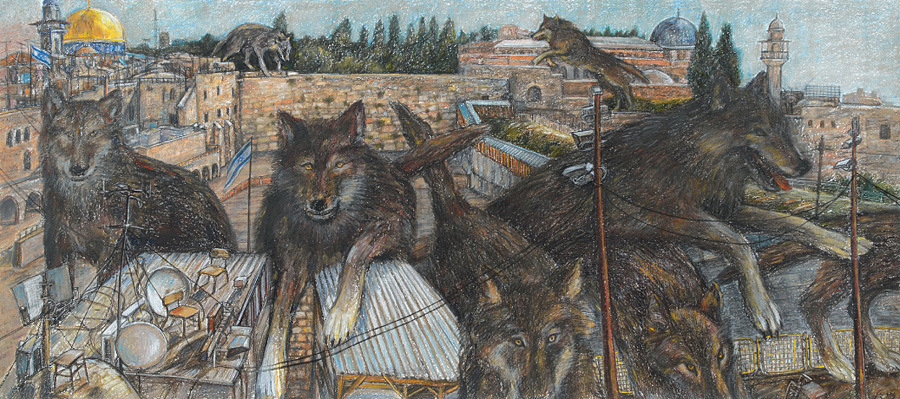
Lena and the Wolves / Monica Lavi
Lena Zaidel presents seven drawings of colored chalk on paper. They are each 230×105 cm (90.5×41.3 inches) in size, depicting scenes of Jerusalem, in which packs of wolves roam its streets. The wolves make their way around the city, seemingly at home, while also invaders, crossing holy sites, climbing the Old City´s walls, traversing the Temple Mount plaza, leaping over cars, and passing over construction sites.
Jerusalem is portrayed as depressed, dirty, abandoned and hostile, a city that barely preserves its past beauty, and its current hallmark is barbed wire. The various sites reflect evidence of human activity – cars, old newspapers, books, even an exhibit catalogue, tinned food, supermarket carts and all sorts of trash. The wolves roam the deserted city both as though it were theirs and as perfect strangers. What is the connection between Jerusalem and wolves?
The drawings are somewhat reminiscent of scenes from the film Twelve Monkeys, directed by Terry Gilliam, set in New York after a deadly virus wipes out most of the people. The city is left to wild animals that roam its streets. Jerusalem´s virus rendered it neglected, deserted and diseased, as though its residents were mysteriously expelled and the city was left to predators.
Zaidel chose wolves as an image of a wild, vitalizing force capable of sparking dramatic change in reality and creating a sense of apocalypse, yet it is also stimulating and liberating. Seen from this point of view, Jerusalem´s malaise seeks a remedy. The remedy is the pack of wolves, prowling the city as though it were not the holy, god-fearing city it is, with a millennia-old history, as though it were not a city sacred to Judaism, Christianity and Islam. It is as though the baggage that the real and the symbolic Jerusalem carry suggests nothing at all to the pack of wolves. Perhaps unintentionally, there is a sense of sacrilege in the drawings. Even a secular, non-religious observer, fidgets uncomfortably at the sight of wolves treating the city as they see fit. Jerusalem – which took nine of the ten measures of beauty that had descended into the world, Jerusalem the golden – is portrayed as a ghost town.
In Women Who Run with Wolves, Jungian analyst Clarissa Pinkola Estés employs the image of a wolf to sketch the archetypical wild woman and expose the instinctual female self buried by layers of culture, laws and restrictions. The healthy woman, according to Estés, is very much like the wolf: strong, vital, granting life, conscious of her territory, inventive, loyal and wandering. In addition, the wild woman has the means to heal; she encompasses all that a woman should be and know, including stories and dreams, words and songs, signs and symbols.
Thus, another interpretation is possible: the two symbols are packed into each other, ostensibly unconnected. If the wolves were to substitute the artist, they would appear to represent the forces of creation, the spirit of freedom, the quest for what lays beyond our reach, and the desire to shed the weight that Jerusalem burdens upon its residents. The wolves are the vital force Lena Zaidel releases into the city she lives in. They are the healthy instincts, physical and mental wellbeing, bringing joy, curiosity, motion and life to a city liberated 40 years ago. The wolves, an image of the psyche´s forces, seek to heal the city, whose connected parts have not yet mended.
Lena Zaidel plays with scales in her drawings. The realism with which she draws the city and the wolves is inconsistent, thus adding an air of illusion and dream to the drawings. The laws governing are those of imagination, not necessarily abiding by the worldly laws, or those of drawing. As a result, Jerusalem sometimes looks like a miniature model of itself, such as the Holy Land Model. Upsetting the proportions sparks misconception in the observer, who is now outside the comfort zone of observation. Discomfort is enhanced by Zaidel´s choice of medium for her large drawings: dry pastel chalk on paper. The compactness of the chalk, its squeakiness and the temporary nature of pigment on paper, along with the sense that the modest pastel chalk has been charged with a task beyond its capacity all lend Zaidel´s work a sense of instability and dissonance.
Yet there is a glimmer of catharsis in the sight of wolves roaming Jerusalem that is cleansing, purifying and liberating. It is as though something inevitably must happen to the sacred symbols that have been deeply assimilated culturally, awaiting the liberating wolf and its emotional powers before being tamed, oppressed and conquered in the name of god and man.
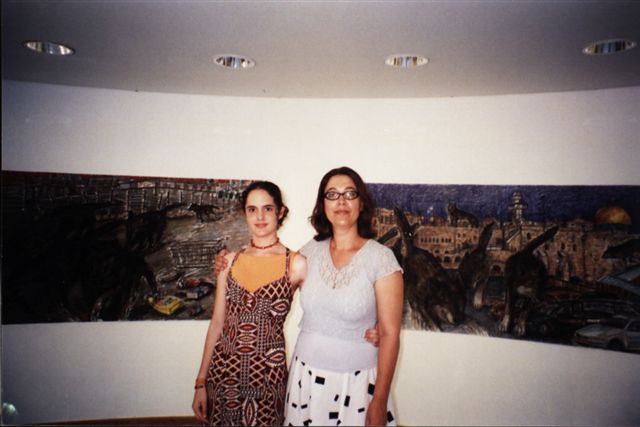
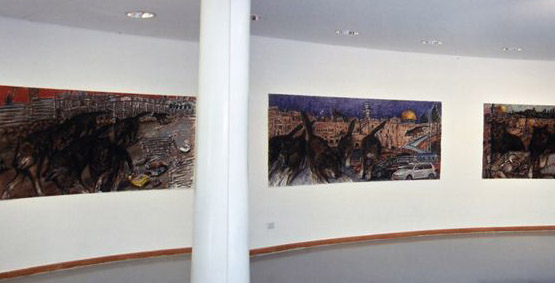
Frames from the movie “12 monkeys” (1995) by Terry Gilliam
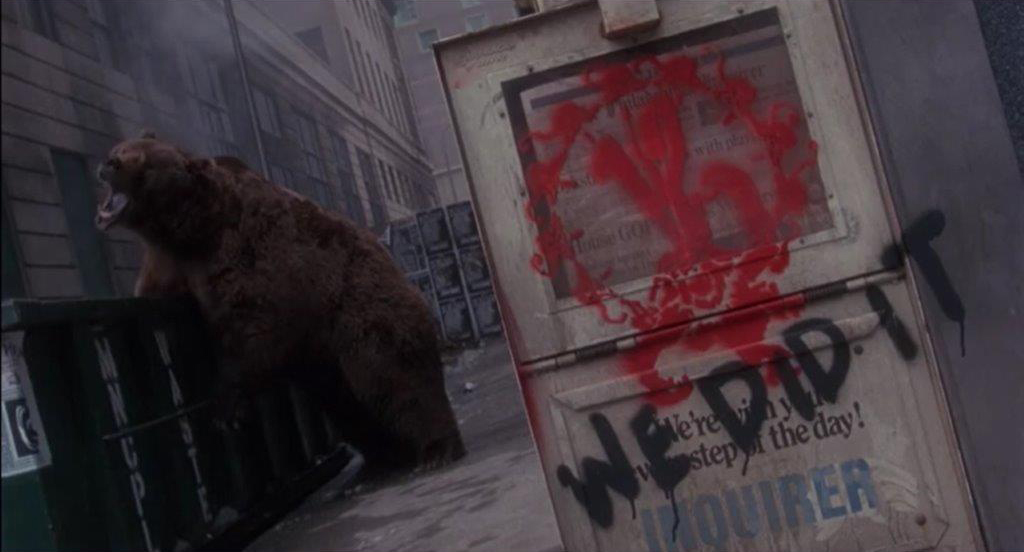
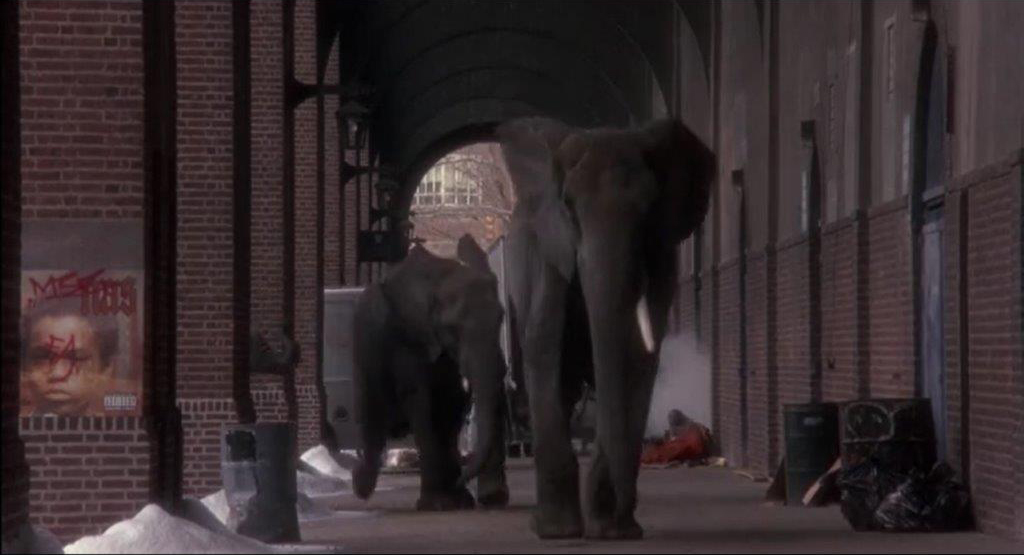

Corona quarantine in Israel, March-April 2020
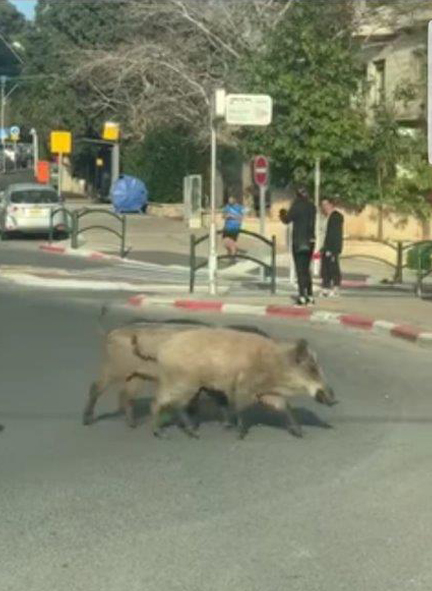


Show More